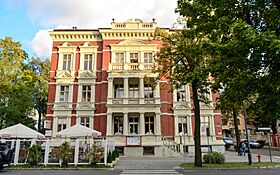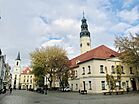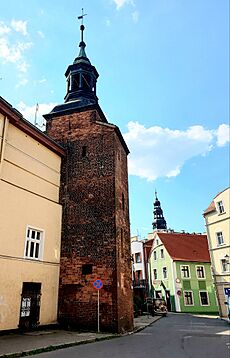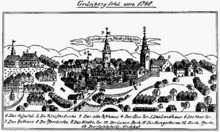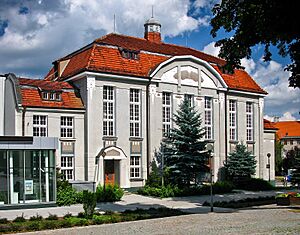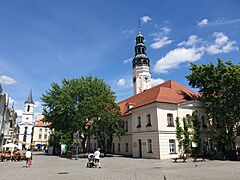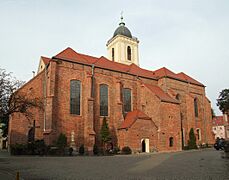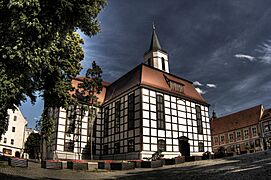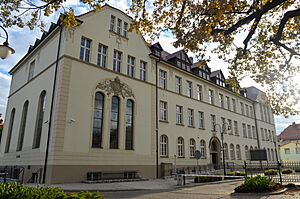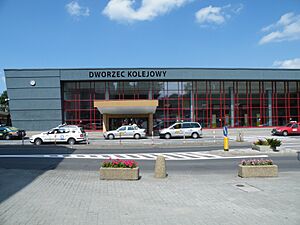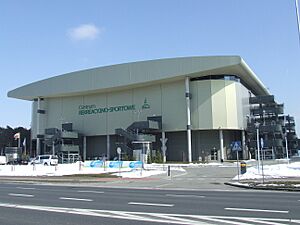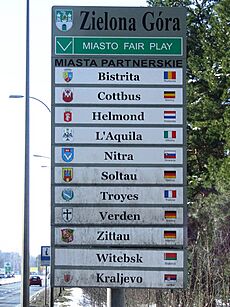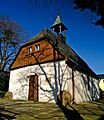Zielona Góra facts for kids
Quick facts for kids
Zielona Góra
|
|||||
|---|---|---|---|---|---|
|
|||||
|
|||||
| Motto(s):
Miasto przyszłości
City of the future |
|||||
| Country | |||||
| Voivodeship | Lubusz | ||||
| County | city county | ||||
| Established | 13th century | ||||
| Town rights | 1323 | ||||
| Area | |||||
| • City | 278.32 km2 (107.46 sq mi) | ||||
| Elevation | 71 m (233 ft) | ||||
| Population
(31 December 2021)
|
|||||
| • City | 140,403 |
||||
| • Density | 510/km2 (1,300/sq mi) | ||||
| • Urban | 216,781 | ||||
| Time zone | UTC+1 (CET) | ||||
| • Summer (DST) | UTC+2 (CEST) | ||||
| Postal code |
65-001 to 65-950
|
||||
| Area code(s) | +48 68 | ||||
| Car plates | FZ/FZI | ||||
| Climate | Cfb | ||||
| GDP | 2017 | ||||
| – Total | Nominal: €10 billion PPP: $14 billion |
||||
| – Per capita | Nominal: €17,300 PPP: $20,900 |
||||
| Primary airport | Zielona Góra Airport | ||||
| Highways | |||||
Zielona Góra is a large city in western Poland. Its name means Green Mountain in Polish. About 140,403 people lived there in 2021. It's one of the two capital cities of the Lubusz Voivodeship region.
The area is famous for its vineyards and holds a fun Wine Fest every year. The first settlers came to this area in 1222. Zielona Góra officially became a town in 1323. Over the centuries, it was part of different countries, including the Kingdom of Bohemia, the Habsburg monarchy, and the Kingdom of Prussia. After World War II in 1945, it became part of Poland again.
Contents
History of Zielona Góra
Early Beginnings
The first small village in the Zielona Góra area was built near the Złota Łącza stream. This happened when Poland was ruled by Mieszko I. The first people living here were farmers. Later, it became a trading spot on important routes. Records show that more people moved here in 1222.
In the late 1200s, more people came to the area. In 1323, Zielona Góra officially became a city. It was given special "town rights" that allowed it to grow. The city's coat of arms was first mentioned in 1421.
In 1294, Duke Henryk III started building a church. It was named after Saint Hedwig, a Polish saint. This church is the oldest building in the city today.
Changes and Challenges
The city was part of the Kingdom of Bohemia starting in 1506. During this time, Zielona Góra became known for making cloth. In 1505, the Polish King allowed cloth from Zielona Góra to be sold all over Poland. Winemaking was also very important to the city's economy.
In the 1600s, the city faced tough times. There were wars, debts, and fires. During this period, there were also unfair trials where people were accused of witchcraft. In 1669, the local court was stopped from giving the death penalty in these cases.
In 1742, Zielona Góra became part of the Kingdom of Prussia. The Prussians allowed different religions, and a Protestant church was built. However, Polish Catholics faced some unfair treatment later on.
Modern Times
By the late 1700s, the city's textile industry was doing very well. Many parts of the old city walls were taken down to let the city grow. The textile industry changed in the 1820s as new machines were invented.
In the 1800s, many Poles moved to German cities for work. A Polish craftsmen's group was started in Zielona Góra in 1898. It helped Polish workers until 1935. In 1923, a branch of the Union of Poles in Germany was also created here.
In 1871, Zielona Góra became part of the German Empire. English business owners bought some of the city's textile factories. The city also got its first railway connection in 1871.
During World War II, the Germans used 42 forced labor camps in the city. People from Poland, Russia, Ukraine, Britain, France, and Italy were forced to work there. There were also three smaller camps for Jewish people. In January 1945, many Jewish women were forced to march through the city as part of a "death march."
On February 14, 1945, the Soviet Red Army took over Zielona Góra with little fighting. After the war, the city became part of Poland again. Many German residents left, and Polish people from other parts of Poland moved in. The city was briefly called Zielonogóra before its old Polish name, Zielona Góra, was brought back.
Recent History
From 1950 to 1998, Zielona Góra was the capital of its own region, the Zielona Góra Voivodeship. The city grew quickly after the war. By 1950, it had more people than ever before.
In 2001, the University of Zielona Góra was opened. The city is also an important center for the Roman Catholic Church in the region.
Geography and Nature
Zielona Góra is surrounded by beautiful, tree-covered hills. About half of the city's area is covered by forests. This is why its name means 'Green Mountain'.
The city has many interesting places to visit. You can explore the old medieval town, the 13th-century Market Square, and the famous Palm House on Wine Hill. Because of its strong connection to vineyards and grapes, Zielona Góra is often called "The City of Wine."
Wineries and Local Drinks
Zielona Góra has been known for its wines for hundreds of years. It's one of the few places in Poland where wine grapes are grown, mostly for white wines. The first wineries around the city were built in 1314. At one point, there were about 4,000 vineyards in the region, with 2,500 in Zielona Góra itself!
Even though wine production slowed down during the communist era, it has grown again since 1990. Every year since 1852, there's been an exciting wine festival in the town. While wine isn't made in the city center anymore, the tradition lives on.
Besides wine, Zielona Góra also makes special vodkas. Luksusowa vodka, made from potatoes, is produced here. Another traditional drink is Jarzębiak, a Polish fruit vodka made from rowan berries. The city also has a long history of brewing its own beer, dating back to the 1700s.
Climate
The climate in Zielona Góra is mild, with influences from the ocean. This means it has warm summers and cool winters.
| Climate data for Zielona Gora (Słowackiego), elevation: 192 m, 1991–2020 normals, extremes 1951–present | |||||||||||||
|---|---|---|---|---|---|---|---|---|---|---|---|---|---|
| Month | Jan | Feb | Mar | Apr | May | Jun | Jul | Aug | Sep | Oct | Nov | Dec | Year |
| Record high °C (°F) | 15.1 (59.2) |
20.4 (68.7) |
24.2 (75.6) |
30.4 (86.7) |
31.2 (88.2) |
36.9 (98.4) |
36.6 (97.9) |
36.8 (98.2) |
32.7 (90.9) |
27.6 (81.7) |
19.8 (67.6) |
15.4 (59.7) |
36.9 (98.4) |
| Mean daily maximum °C (°F) | 2.2 (36.0) |
3.8 (38.8) |
8.0 (46.4) |
14.5 (58.1) |
19.2 (66.6) |
22.4 (72.3) |
24.5 (76.1) |
24.2 (75.6) |
18.9 (66.0) |
13.0 (55.4) |
6.8 (44.2) |
3.1 (37.6) |
13.4 (56.1) |
| Daily mean °C (°F) | −0.3 (31.5) |
0.7 (33.3) |
4.0 (39.2) |
9.6 (49.3) |
14.0 (57.2) |
17.3 (63.1) |
19.3 (66.7) |
19.1 (66.4) |
14.4 (57.9) |
9.3 (48.7) |
4.2 (39.6) |
0.8 (33.4) |
9.4 (48.9) |
| Mean daily minimum °C (°F) | −2.6 (27.3) |
−1.8 (28.8) |
0.8 (33.4) |
5.2 (41.4) |
9.5 (49.1) |
12.8 (55.0) |
14.9 (58.8) |
14.7 (58.5) |
10.7 (51.3) |
6.3 (43.3) |
2.0 (35.6) |
−1.4 (29.5) |
5.9 (42.6) |
| Record low °C (°F) | −23.1 (−9.6) |
−29.5 (−21.1) |
−17.2 (1.0) |
−5.9 (21.4) |
−3.4 (25.9) |
2.2 (36.0) |
6.9 (44.4) |
4.5 (40.1) |
1.1 (34.0) |
−5.8 (21.6) |
−12.4 (9.7) |
−20.1 (−4.2) |
−29.5 (−21.1) |
| Average precipitation mm (inches) | 44.2 (1.74) |
35.6 (1.40) |
45.2 (1.78) |
30.6 (1.20) |
52.7 (2.07) |
55.7 (2.19) |
90.1 (3.55) |
65.3 (2.57) |
48.3 (1.90) |
41.0 (1.61) |
40.5 (1.59) |
39.7 (1.56) |
588.8 (23.18) |
| Average extreme snow depth cm (inches) | 6.2 (2.4) |
6.3 (2.5) |
4.0 (1.6) |
1.5 (0.6) |
0.0 (0.0) |
0.0 (0.0) |
0.0 (0.0) |
0.0 (0.0) |
0.0 (0.0) |
0.3 (0.1) |
1.9 (0.7) |
4.2 (1.7) |
6.3 (2.5) |
| Average precipitation days (≥ 0.1 mm) | 17.97 | 14.66 | 14.63 | 10.90 | 12.47 | 13.17 | 13.90 | 12.37 | 11.23 | 13.53 | 15.57 | 17.17 | 167.56 |
| Average snowy days (≥ 0 cm) | 14.1 | 11.7 | 5.4 | 0.7 | 0.0 | 0.0 | 0.0 | 0.0 | 0.0 | 0.2 | 2.7 | 8.4 | 43.2 |
| Average relative humidity (%) | 87.7 | 83.1 | 76.3 | 65.7 | 66.5 | 67.1 | 67.3 | 68.3 | 76.3 | 83.2 | 89.2 | 89.4 | 76.6 |
| Mean monthly sunshine hours | 51.7 | 73.9 | 121.8 | 189.9 | 225.1 | 224.1 | 239.3 | 229.0 | 159.5 | 111.6 | 56.6 | 42.1 | 1,724.7 |
| Source 1: Institute of Meteorology and Water Management | |||||||||||||
| Source 2: Meteomodel.pl (records, relative humidity 1991–2020) | |||||||||||||
Population Over Time
| Historical population | ||||||||||||||||||||||||||||||||||||||||||||||
|---|---|---|---|---|---|---|---|---|---|---|---|---|---|---|---|---|---|---|---|---|---|---|---|---|---|---|---|---|---|---|---|---|---|---|---|---|---|---|---|---|---|---|---|---|---|---|
|
|
|||||||||||||||||||||||||||||||||||||||||||||
| source | ||||||||||||||||||||||||||||||||||||||||||||||
Places to See
Some of the most interesting places in Zielona Góra are:
- Market Square (Rynek) with the town hall
- Co-cathedral church of St Hedwig of Silesia - a Gothic church that has been changed over time
- Our Lady of Częstochowa church - an old church from the 1700s
- Łaziebna tower - a part of the old city walls
- Palm house - a special building with palm trees
Education in Zielona Góra
Zielona Góra has a university and other colleges. About 18,000 students study in the city.
High Schools
- I High School
- III High School
- IV High School
- V High School
- Seventh General Lyceum
- Schools of Electronics
- Schools of Economics
Universities and Colleges
- University of Zielona Góra
Getting Around
Zielona Góra Airport is located just outside the city. It's an important airport for western Poland. You can fly from here to Warsaw.
The city is connected by major roads, including S3 Expressway.
Zielona Góra Główna railway station is the main train station. You can take trains to many Polish cities like Warsaw, Kraków, Poznań, Szczecin, and Wrocław. There are also international trains to Berlin and Vienna.
Events and Festivals
- June/July: Busker Bus Festival - a festival with street performers.
- August: Folk Song and Dance Festival - celebrating traditional music and dance.
- September: Winobranie (Wine Fest) - the famous annual wine festival.
Sports Teams
Zielona Góra is home to some great sports teams:
- Zastal Zielona Góra - a very successful basketball team that has won the Polish Basketball League five times. They play at the CRS Hall Zielona Góra.
- Falubaz Zielona Góra - one of Poland's best motorcycle speedway clubs.
- Lechia Zielona Góra - the local football (soccer) team.
Famous People from Zielona Góra
Many notable people were born or lived in Zielona Góra:
- Rudolf Haym (1821–1901), a philosopher.
- Wilhelm Foerster (1832–1921), an astronomer.
- Maryla Rodowicz (born 1945), a famous singer.
- Olga Tokarczuk (born 1962), a writer who won the Nobel Prize in Literature.
- Piotr Protasiewicz (born 1975), a well-known speedway rider.
- Mateusz Kieliszkowski (born 1993), a top international strongman competitor.
Sister Cities
Zielona Góra has special connections with other cities around the world, called "sister cities":
 L'Aquila, Italy (1996)
L'Aquila, Italy (1996) Bistriţa, Romania (2001)
Bistriţa, Romania (2001) Cottbus, Germany (1990)
Cottbus, Germany (1990) Helmond, Netherlands (1993)
Helmond, Netherlands (1993) Ivano-Frankivsk, Ukraine (2000)
Ivano-Frankivsk, Ukraine (2000) Kraljevo, Serbia (1974)
Kraljevo, Serbia (1974) Nitra, Slovakia (1992)
Nitra, Slovakia (1992) Troyes, France (1970)
Troyes, France (1970) Verden an der Aller, Germany (1993)
Verden an der Aller, Germany (1993) Batumi, Georgia (2022)
Batumi, Georgia (2022) Wuxi, China (2009)
Wuxi, China (2009) Zittau, Germany (2010)
Zittau, Germany (2010)
Friendly Cities
Images for kids
-
Lutheran church
-
Ignacy Łukasiewicz Monument
See also
 In Spanish: Zielona Góra para niños
In Spanish: Zielona Góra para niños


